Portal:Jazz/Selected biography/Archive
| This page is currently inactive and is retained for historical reference. Either the page is no longer relevant or consensus on its purpose has become unclear. To revive discussion, seek broader input via a forum such as the village pump. |
This page displays all the articles which have appeared in the "selected biography" section of the Jazz portal. Instructions on how to add new articles to this list are here.
1[edit]
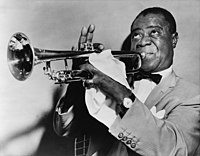
Louis Armstrong (August 4, 1901 – July 6, 1971), or Pops, was an American jazz trumpeter, singer, and an influential figure in jazz music.
Coming to prominence in the 1920s as an "inventive" trumpet and cornet player, Armstrong was a foundational influence in jazz, shifting the focus of the music from collective improvisation to solo performance. With his instantly recognizable gravelly voice, Armstrong was also an influential singer, demonstrating great dexterity as an improviser, bending the lyrics and melody of a song for expressive purposes. He was also skilled at scat singing (vocalizing using sounds and syllables instead of actual lyrics).
Renowned for his charismatic stage presence and voice almost as much as for his trumpet-playing, Armstrong's influence extends well beyond jazz music, and by the end of his career in the 1960s, he was widely regarded as a profound influence on popular music in general. Armstrong was one of the first truly popular African-American entertainers to "cross over", whose skin color was secondary to his music in an America that was severely racially divided. He rarely publicly politicized his race, often to the dismay of fellow African-Americans, but took a well-publicized stand for desegregation during the Little Rock Crisis. His artistry and personality allowed him socially acceptable access to the upper echelons of American society that were highly restricted for a black man. (Full article...)
2[edit]
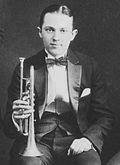
Leon Bismark "Bix" Beiderbecke (March 10, 1903 – August 6, 1931) was an American jazz cornetist, jazz pianist, and composer.
With Louis Armstrong and Muggsy Spanier, Beiderbecke was one of the most influential jazz soloists of the 1920s. His turns on "Singin' the Blues" and "I'm Coming, Virginia" (both 1927), in particular, demonstrated an unusual purity of tone and a gift for improvisation. With these two recordings, especially, he helped to invent the jazz ballad style and hinted at what, in the 1950s, would become cool jazz. "In a Mist" (1927), one of a handful of his piano compositions and one of only two he recorded, mixed classical (Impressionist) influences with jazz syncopation.
A native of Davenport, Iowa, Beiderbecke taught himself to play cornet largely by ear, leading him to adopt a non-standard fingering some critics have connected to his original sound. He first recorded with Midwestern jazz ensembles, The Wolverines and The Bucktown Five in 1924, after which he played briefly for the Detroit-based Jean Goldkette Orchestra before joining Frankie "Tram" Trumbauer for an extended gig at the Arcadia Ballroom in St. Louis. Beiderbecke and Trumbauer joined Goldkette in 1926. The band toured widely and famously played a set opposite Fletcher Henderson at the Roseland Ballroom in New York City in October 1926. He made his greatest recordings in 1927 (see above). In 1928, Trumbauer and Beiderbecke left Detroit to join the best-known and most prestigious dance orchestra in the country: the New-York-based Paul Whiteman Orchestra. (Full article...)
3[edit]
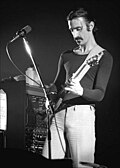
Frank Vincent Zappa (December 21, 1940 – December 4, 1993) was an American musician, bandleader, songwriter, composer, recording engineer, record producer, and film director. In a career spanning more than 30 years, Zappa composed rock, jazz, orchestral and musique concrète works. He also directed feature-length films and music videos, and designed album covers. Zappa produced almost all of the more than 60 albums he released with the band The Mothers of Invention and as a solo artist. While in his teens, he acquired a taste for 20th-century classical composers such as Edgard Varèse, Igor Stravinsky, and Anton Webern, along with 1950s rhythm and blues music. He began writing classical music in high school, while at the same time playing drums in rhythm and blues bands; he later switched to electric guitar.
Zappa was a self-taught composer and performer, and his diverse musical influences led him to create music that was often difficult to categorize. His 1966 debut album with the Mothers of Invention, Freak Out!, combined songs in conventional rock and roll format with collective improvisations and studio-generated sound collages. His later albums shared this eclectic and experimental approach, irrespective of whether the fundamental format was rock, jazz or classical. His lyrics—often humorously—reflected his iconoclastic view of established social and political processes, structures and movements. He was a strident critic of mainstream education and organized religion, and a forthright and passionate advocate for freedom of speech, self-education, political participation and the abolition of censorship. (Full article...)
4[edit]

Arthur Stewart "Art" Farmer (August 21, 1928 – October 4, 1999) was an American jazz trumpeter and flugelhorn player. He also played flumpet, a trumpet–flugelhorn combination specially designed for him. He and his identical twin brother, double bassist Addison Farmer, started playing professionally while in high school. Art gained greater attention after the release of a recording of his composition "Farmer's Market" in 1952. He subsequently moved from Los Angeles to New York, where he performed and recorded with musicians such as Horace Silver, Sonny Rollins, and Gigi Gryce and became known principally as a bebop player.
As Farmer's reputation grew, he expanded from bebop into more experimental forms through working with composers such as George Russell and Teddy Charles. He went on to join Gerry Mulligan's quartet and, with Benny Golson, to co-found the Jazztet. Continuing to develop his own sound, Farmer switched from trumpet to the warmer flugelhorn in the early 1960s, and he helped to establish the flugelhorn as a soloist's instrument in jazz. He settled in Europe in 1968 and continued to tour internationally until his death. Farmer recorded more than 50 albums under his own name, a dozen with the Jazztet, and dozens more with other leaders. His playing is known for its individuality – most noticeably, its lyricism, warmth of tone and sensitivity. (Full article...)
5[edit]
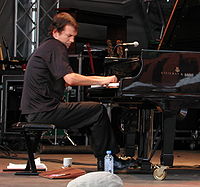
Bradford Alexander "Brad" Mehldau (/ˈmɛlˌdaʊ/; born August 23, 1970) is an American jazz pianist, composer, and arranger.
Mehldau studied music at The New School, and toured and recorded while still a student. He was a member of saxophonist Joshua Redman's Quartet with bassist Christian McBride and drummer Brian Blade in the mid-1990s, and has led his own trio since at least 1992. His first long-term trio featured bassist Larry Grenadier and drummer Jorge Rossy; in 2005 Jeff Ballard replaced Rossy. These bands have released a dozen albums under the pianist's name.
Since the early 2000s Mehldau has experimented with other musical formats in addition to trio and solo piano. Largo, released in 2002, contains electronics and input from rock and classical musicians; later examples include touring and recording with guitarist Pat Metheny, writing and playing song cycles for classical singers Renée Fleming and Anne Sofie von Otter, composing orchestral pieces for 2009's Highway Rider, and playing electronic keyboard instruments in a duo with drummer Mark Guiliana.
Aspects of pop, rock, and classical music, including German Romanticism, have been absorbed into Mehldau's writing and playing. Through his use of some traditional elements of jazz without being restricted by them, simultaneous playing of different melodies in separate hands, and incorporation of pop and rock pieces, Mehldau has influenced musicians in and beyond jazz in their approaches to writing, playing, and choice of repertoire. (Full article...)
6[edit]

Ketevan "Katie" Melua (/ˈmɛluːə/; Georgian: ქეთევან "ქეთი" მელუა [mɛluɑ]; born 16 September 1984) is a Georgian-British singer, songwriter and musician. She moved to Northern Ireland at the age of eight and then to England at fourteen. Melua is signed to the small Dramatico record label, under the management of composer Mike Batt, and made her musical debut in 2003. In 2006, she was the United Kingdom's best-selling female artist and Europe's highest selling European female artist. (Full article...)
7[edit]
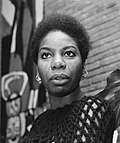
Nina Simone /ˈniːnə sɪˈmoʊn/ (born Eunice Kathleen Waymon; February 21, 1933 – April 21, 2003) was an American singer, songwriter, pianist, arranger, and civil rights activist widely associated with jazz music. She worked in a broad range of styles including classical, jazz, blues, folk, R&B, gospel, and pop.
The sixth child of a preacher's family in North Carolina, Simone aspired to be a concert pianist. Her musical path changed direction after she was denied a scholarship to the prestigious Curtis Institute of Music in Philadelphia, despite a well-received audition. Simone was later told by someone working at Curtis that she was rejected because she was black. So as to fund her continuing musical education and become a classical pianist, she began playing in a small club in Philadelphia where she was also required to sing. She was approached for a recording by Bethlehem Records, and her rendering of "I Loves You, Porgy" was a hit in the United States in 1958. Over the length of her career Simone recorded more than 40 albums, mostly between 1958, when she made her debut with Little Girl Blue, and 1974. (Full article...)
8[edit]

Shelly Manne (June 11, 1920 – September 26, 1984), born Sheldon Manne in New York City, was an American jazz drummer. Most frequently associated with West Coast jazz, he was known for his versatility and also played in a number of other styles, including Dixieland, swing, bebop, avant-garde jazz and fusion, as well as contributing to the musical background of hundreds of Hollywood films and television programs. (Full article...)
9[edit]

Anthony Dominick "Tony" Benedetto (born August 3, 1926), known as Tony Bennett, is an American singer of traditional pop standards, show tunes, and jazz. Bennett is also an accomplished painter, having created works—under the name Anthony Benedetto—that are on permanent public display in several institutions. He is the founder of the Frank Sinatra School of the Arts in New York City.
Raised in New York City, Bennett began singing at an early age. He fought in the final stages of World War II as an infantryman with the U.S. Army in the European Theatre. Afterwards, he developed his singing technique, signed with Columbia Records, and had his first number-one popular song with "Because of You" in 1951. Several top hits such as "Rags to Riches" followed in the early 1950s. Bennett then further refined his approach to encompass jazz singing. He reached an artistic peak in the late 1950s with albums such as The Beat of My Heart and Basie Swings, Bennett Sings. In 1962, Bennett recorded his signature song, "I Left My Heart in San Francisco". His career and his personal life then suffered an extended downturn during the height of the rock music era.
Bennett staged a comeback in the late 1980s and 1990s, putting out gold record albums again and expanding his audience to the MTV Generation while keeping his musical style intact. He remains a popular and critically praised recording artist and concert performer in the 2010s. Bennett has won 17 Grammy Awards (including a Lifetime Achievement Award, presented in 2001) and two Emmy Awards, and has been named an NEA Jazz Master and a Kennedy Center Honoree. He has sold over 50 million records worldwide. (Full article...)
10[edit]

Arthur "Art" Tatum, Jr. (/ˈteɪtəm/, October 13, 1909 – November 5, 1956) was an American jazz pianist.
Tatum is widely acknowledged as a virtuoso and one of the greatest jazz pianists of all time, and was a major influence on later generations of jazz pianists. He was hailed for the technical proficiency of his performances, which set a new standard for jazz piano virtuosity. Critic Scott Yanow wrote, "Tatum's quick reflexes and boundless imagination kept his improvisations filled with fresh (and sometimes futuristic) ideas that put him way ahead of his contemporaries." (Full article...)
11[edit]

Benjamin David "Benny" Goodman (May 30, 1909 – June 13, 1986) was an American jazz and swing musician, clarinetist and bandleader, known as the "King of Swing".
In the mid-1930s, Benny Goodman led one of the most popular musical groups in America. His January 16, 1938 concert at Carnegie Hall in New York City is described by critic Bruce Eder as "the single most important jazz or popular music concert in history: jazz's 'coming out' party to the world of 'respectable' music."
Goodman's bands launched the careers of many major names in jazz. During an era of segregation he also led one of the first well-known integrated jazz groups. Goodman continued to perform to nearly the end of his life, while exploring an interest in classical music. (Full article...)
12[edit]
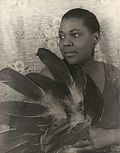
Bessie Smith (April 15, 1894 – September 26, 1937) was an American blues singer.
Nicknamed The Empress of the Blues, Smith was the most popular female blues singer of the 1920s and 1930s. She is often regarded as one of the greatest singers of her era and, along with Louis Armstrong, a major influence on other jazz vocalists.
Smith began forming her own act around 1913, at Atlanta's "81" Theater. By 1920, Smith had established a reputation in the South and along the Eastern Seaboard. In 1920, sales figures of over 100,000 copies for "Crazy Blues," an Okeh Records recording by singer Mamie Smith (no relation) pointed to a new market. The recording industry had not directed its product to blacks, but the success of the record led to a search for female blues singers. Bessie Smith was signed by Columbia Records in 1923 and her first session for Columbia was February 15, 1923. For most of 1923, her records were issued on Columbia's regular A- series; when the label decided to establish a "race records" series, Smith's "Cemetery Blues" (September 26, 1923) was the first issued. (Full article...)
13[edit]
William John Evans, known as Bill Evans ( /ˈɛvəns/, August 16, 1929 – September 15, 1980), was an American jazz pianist and composer who mostly worked in a trio setting. He is widely considered to be one of the greatest jazz pianists of all time, and is considered by some to have been the most influential post-World War II jazz pianist. Evans's use of impressionist harmony, inventive interpretation of traditional jazz repertoire, block chords, and trademark rhythmically independent, "singing" melodic lines continue to influence jazz pianists today. Unlike many other jazz musicians of his time, Evans never embraced new movements like jazz fusion or free jazz. (Full article...)
14[edit]

Billie Holiday (born Eleanora Fagan; April 7, 1915 – July 17, 1959) was an American jazz singer and songwriter. Nicknamed "Lady Day" by her friend and musical partner Lester Young, Holiday had a seminal influence on jazz and pop singing. Her vocal style, strongly inspired by jazz instrumentalists, pioneered a new way of manipulating phrasing and tempo.
Holiday was signed to Brunswick Records by John Hammond to record current pop tunes with Teddy Wilson in the new "swing" style for the growing jukebox trade. They were given free rein to improvise the material. Holiday's improvisation of the melody line to fit the emotion was revolutionary. (Full article...)
15[edit]

Charles "Charlie" Parker, Jr. (August 29, 1920 – March 12, 1955), also known as "Yardbird" and "Bird", was an American jazz saxophonist and composer.
Parker was a highly influential jazz soloist and a leading figure in the development of bebop, a form of jazz characterized by fast tempos, virtuosic technique and improvisation. Parker introduced revolutionary harmonic ideas including rapid passing chords, new variants of altered chords, and chord substitutions. His tone ranged from clean and penetrating to sweet and somber. Many Parker recordings demonstrate his virtuoso playing style and complex melodic lines, sometimes combining jazz with other musical genres, including blues, Latin, and classical.
Parker acquired the nickname "Yardbird" early in his career; this and its shortened form, "Bird", which continued to be used for the rest of his life, inspired the titles of a number of Parker compositions, such as "Yardbird Suite", "Ornithology", "Bird Gets the Worm", and "Bird of Paradise."
Parker was an icon for the hipster subculture and later the Beat Generation, personifying the jazz musician as an uncompromising artist and intellectual rather than just an entertainer. (Full article...)
16[edit]

Thelonious Sphere Monk (October 10, 1917 – February 17, 1982) was an American jazz pianist and composer, considered one of the giants of American music. Monk had a unique improvisational style and made numerous contributions to the standard jazz repertoire, including "Epistrophy", "'Round Midnight", "Blue Monk", "Straight, No Chaser" and "Well, You Needn't". Monk is the second-most recorded jazz composer after Duke Ellington, which is particularly remarkable as Ellington composed over 1,000 songs while Monk wrote about 70.
His compositions and improvisations feature dissonances and angular melodic twists, and are consistent with Monk's unorthodox approach to the piano, which combined a highly percussive attack with abrupt, dramatic use of silences and hesitations. This style was not universally appreciated, shown for instance in poet and jazz critic Philip Larkin's dismissal of Monk as "the elephant on the keyboard".
He was renowned for his distinctive style in suits, hats, and sunglasses. He was also noted for an idiosyncratic habit observed at times during performances: while the other musicians in the band continued playing, he would stop, stand up from the keyboard, and dance for a few moments before returning to the piano.
Monk is one of five jazz musicians to have been featured on the cover of Time, after Louis Armstrong, Dave Brubeck, and Duke Ellington, and before Wynton Marsalis. (Full article...)
17[edit]

William James "Count" Basie (August 21, 1904 – April 26, 1984) was an American jazz pianist, organist, bandleader, and composer. His mother taught him to play the piano and he started performing in his teens. Dropping out of school, he learned to operate lights for vaudeville and to improvise accompaniment for silent films at a local movie theater in his home town of Red Bank, New Jersey. By 16, he increasingly played jazz piano at parties, resorts and other venues. In 1924, he went to Harlem, where his performing career expanded; he toured with groups to the major jazz cities of Chicago, St. Louis and Kansas City. In 1929 he joined Bennie Moten's band in Kansas City, and played with them until Moten's death in 1935.
That year Basie formed his own jazz orchestra, and in 1936 took them to Chicago for a long engagement and their first recording. He led the group for almost 50 years, creating innovations like the use of two "split" tenor saxophones, emphasizing the rhythm section, riffing with a big band, using arrangers to broaden their sound, and others. Many notable musicians came to prominence under his direction, including the tenor saxophonists Lester Young and Herschel Evans, the guitarist Freddie Green, trumpeters Buck Clayton and Harry "Sweets" Edison and singers Jimmy Rushing and Joe Williams. Basie's theme songs were "One O'Clock Jump," developed in 1935 in the early days of his band, and "April In Paris". (Full article...)
18[edit]

John Birks "Dizzy" Gillespie (/ɡɪˈlɛspi/; October 21, 1917 – January 6, 1993) was an American jazz trumpeter, bandleader, composer and occasional singer.
Allmusic's Scott Yanow wrote, "Dizzy Gillespie's contributions to jazz were huge. One of the greatest jazz trumpeters of all time (some would say the best), Gillespie was such a complex player that his contemporaries ended up copying Miles Davis and Fats Navarro instead, and it was not until Jon Faddis's emergence in the 1970s that Dizzy's style was successfully recreated [...] Arguably Gillespie is remembered, by both critics and fans alike, as one of the greatest jazz trumpeters of all time."
Gillespie was a trumpet virtuoso and improviser, building on the virtuoso style of Roy Eldridge but adding layers of harmonic complexity previously unknown in jazz. He was an early player of bebop. (Full article...)
19[edit]

Jean-Baptiste "Django" Reinhardt (French: [dʒãŋɡo ʁɛjnaʁt] or [dʒɑ̃ɡo ʁenɑʁt]; 23 January 1910 – 16 May 1953) was a French guitarist and composer of Romani heritage.
Reinhardt is often regarded as one of the greatest guitar players of all time and was the first important European jazz musician who made major contributions to the development of the genre. After his third and fourth fingers were paralyzed when he suffered burns in a fire, Reinhardt used only the index and middle fingers of his left hand on his solos and invented an entirely new style of jazz guitar technique (sometimes called 'hot' jazz guitar) that has since become a living musical tradition within French Gypsy culture. With violinist Stéphane Grappelli, he co-founded the Quintette du Hot Club de France, described by critic Thom Jurek as "one of the most original bands in the history of recorded jazz." Reinhardt's most popular compositions have become jazz standards, including "Minor Swing", "Daphne", "Belleville", "Djangology", "Swing '42", and "Nuages". (Full article...)
20[edit]

Edward Kennedy "Duke" Ellington (April 29, 1899 – May 24, 1974) was an American composer, pianist and bandleader of jazz orchestras. He led his orchestra from 1923 until his death, his career spanning over 50 years.
Born in Washington, D.C., Ellington was based in New York City from the mid-1920s onward, and gained a national profile through his orchestra's appearances at the Cotton Club. In the 1930s, his orchestra toured in Europe. Though widely considered to have been a pivotal figure in the history of jazz, Ellington himself embraced the phrase "beyond category" as a "liberating principle", and referred his music to the more general category of "American Music", rather than to a musical genre such as "jazz".
Some of the musicians who were members of Ellington's orchestra, such as saxophonist Johnny Hodges, are still, in their own right, considered to be among the best players in jazz, but it was Ellington who melded them into the best-known orchestral unit in the history of jazz. Some members of the orchestra remained members for several decades. A master at writing miniatures for the three-minute 78 rpm recording format, Ellington often composed specifically for the style and skills of his individual musicians, such as "Jeep's Blues" for Hodges, and "Concerto for Cootie" for trumpeter Cootie Williams, which later became "Do Nothing Till You Hear from Me" with Bob Russell's lyrics. (Full article...)
21[edit]

Sarah Lois Vaughan (March 27, 1924 – April 3, 1990) was an American jazz singer, described by music critic Scott Yanow as having "one of the most wondrous voices of the 20th century."
Nicknamed "Sassy", "The Divine One" and "Sailor" (for her salty speech), Sarah Vaughan was a Grammy Award winner. The National Endowment for the Arts bestowed upon her its "highest honor in jazz", the NEA Jazz Masters Award, in 1989.
Vaughan began her solo career in 1945 by freelancing in clubs on New York's 52nd Street such as the Three Deuces, the Famous Door, the Downbeat and the Onyx Club. Vaughan also hung around the Braddock Grill, next door to the Apollo Theater in Harlem. On May 11, 1945, Vaughan recorded "Lover Man" for the Guild label with a quintet featuring Gillespie and Parker with Al Haig on piano, Curley Russell on double bass and Sid Catlett on drums. Later that month she went into the studio with a slightly different and larger Gillespie/Parker aggregation and recorded three more sides. (Full article...)
22[edit]

Gerald Joseph "Gerry" Mulligan (April 6, 1927 – January 20, 1996) was an American jazz saxophonist, clarinetist, composer and arranger. Though Mulligan is primarily known as one of the leading baritone saxophonists in jazz history – playing the instrument with a light and airy tone in the era of cool jazz – he was also a notable arranger, working with Claude Thornhill, Miles Davis, Stan Kenton, and others. Mulligan's pianoless quartet of the early 1950s with trumpeter Chet Baker is still regarded as one of the more important cool jazz groups. Mulligan was also a skilled pianist and played several other reed instruments. (Full article...)
23[edit]

Jan Garbarek (born 4 March 1947) is a Norwegian tenor and soprano saxophonist, active in the jazz, classical, and world music genres.
He began his recording career in the late 1960s, featuring on recordings by the American jazz composer George Russell (such as Electronic Sonata for Souls Loved by Nature). If he had initially appeared as a devotee of Albert Ayler and Peter Brötzmann, by 1973 he had turned his back on the harsh dissonances of avant-garde jazz, retaining only his tone from his previous approach. Garbarek gained wider recognition through his work with pianist Keith Jarrett's European Quartet which released the albums Belonging (1974), My Song (1977) and the live recordings Personal Mountains (1979), and Nude Ants (1979). He was also a featured soloist on Jarrett's orchestral works Luminessence (1974) and Arbour Zena (1975). (Full article...)
24[edit]

Ferdinand Joseph LaMothe (October 20, 1890 – July 10, 1941), known professionally as Jelly Roll Morton, was an American ragtime and early jazz pianist, bandleader and composer who started his career in New Orleans.
Widely recognized as a pivotal figure in early jazz, Morton is perhaps most notable as jazz's first arranger, proving that a genre rooted in improvisation could retain its essential spirit and characteristics when notated. His composition "Jelly Roll Blues" was the first published jazz composition, in 1915. Morton is also notable for naming and popularizing the "Spanish Tinge" (habanera rhythm and tresillo), and for writing such standards as "King Porter Stomp", "Wolverine Blues", "Black Bottom Stomp", and "I Thought I Heard Buddy Bolden Say", the latter a tribute to New Orleans personalities from the turn of the 19th century to 20th century. (Full article...)
25[edit]
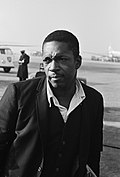
John William Coltrane also known as Coltrane or simply "Trane" (September 23, 1926 – July 17, 1967), was an American jazz saxophonist and composer. Working in the bebop and hard bop idioms early in his career, Coltrane helped pioneer the use of modes in jazz and was later at the forefront of free jazz. He organized at least fifty recording sessions as a leader during his career, and appeared as a sideman on many other albums, notably with trumpeter Miles Davis and pianist Thelonious Monk.
As his career progressed, Coltrane and his music took on an increasingly spiritual dimension. His second wife was pianist Alice Coltrane and their son Ravi Coltrane is also a saxophonist. Coltrane influenced innumerable musicians, and remains one of the most significant saxophonists in music history. He received many posthumous awards and recognitions, including canonization by the African Orthodox Church as Saint John William Coltrane and a special Pulitzer Prize in 2007. (Full article...)
26[edit]

Philip Catherine (born 27 October 1942 in London, England) is a Belgian jazz guitarist, born to an English mother and a Belgian father, known for his collaborations on numerous albums and with jazz musicians like Chet Baker, Charles Mingus, Dexter Gordon, Richard Galliano, Niels-Henning Ørsted Pedersen, Stéphane Grappelli, Toots Thielemans, Robert Wyatt, Klaus Doldinger, Buddy Guy, Karin Krog, Carla Bley, Mike Mantler and Joachim Kühn, and within the prog-rock band Focus. (Full article...)
27[edit]

Lester Willis Young (August 27, 1909 – March 15, 1959), nicknamed "Pres" or "Prez", was an American jazz tenor saxophonist and occasional clarinetist.
Coming to prominence while a member of Count Basie's orchestra, Young was one of the most influential players on his instrument. In contrast to many of his hard-driving peers, Young played with a relaxed, cool tone and used sophisticated harmonies, using "a free-floating style, wheeling and diving like a gull, banking with low, funky riffs that pleased dancers and listeners alike".
Known for his hip, introverted style, he invented or popularized much of the hipster jargon which came to be associated with the music. (Full article...)
28[edit]

Louis Armstrong (August 4, 1901 – July 6, 1971), or Pops, was an American jazz trumpeter, singer, and an influential figure in jazz music.
Coming to prominence in the 1920s as an "inventive" trumpet and cornet player, Armstrong was a foundational influence in jazz, shifting the focus of the music from collective improvisation to solo performance. With his instantly recognizable gravelly voice, Armstrong was also an influential singer, demonstrating great dexterity as an improviser, bending the lyrics and melody of a song for expressive purposes. He was also skilled at scat singing (vocalizing using sounds and syllables instead of actual lyrics).
Renowned for his charismatic stage presence and voice almost as much as for his trumpet-playing, Armstrong's influence extends well beyond jazz music, and by the end of his career in the 1960s, he was widely regarded as a profound influence on popular music in general. Armstrong was one of the first truly popular African-American entertainers to "cross over", whose skin color was secondary to his music in an America that was severely racially divided. He rarely publicly politicized his race, often to the dismay of fellow African-Americans, but took a well-publicized stand for desegregation during the Little Rock Crisis. His artistry and personality allowed him socially acceptable access to the upper echelons of American society that were highly restricted for a black man. (Full article...)
29[edit]
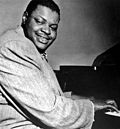
Oscar Emmanuel Peterson CC, CQ, OOnt (August 15, 1925 – December 23, 2007) was a Canadian jazz pianist and composer. He was called the "Maharaja of the keyboard" by Duke Ellington, but simply "O.P." by his friends. He released over 200 recordings, won eight Grammy Awards, and received numerous other awards and honours. He is considered to have been one of the greatest jazz pianists, having played thousands of live concerts to audiences worldwide in a career lasting more than 60 years. (Full article...)
